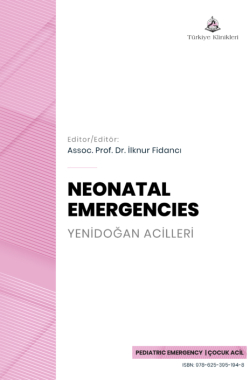Neonatal Transport
Dilek DİLLİa , Zehra ARSLANa
aUniversity of Health Sciences Ankara Etlik City Hospital, Department of Neonatology, Ankara, Türkiye
Dilli D, Arslan Z. Neonatal transport. In: Fidancı İ, ed. Neonatal Emergencies. 1st ed. Ankara: Türkiye Klinikleri; 2024. p.96-102.
ABSTRACT
Some newborn babies should be transferred between hospitals due to the need for advanced intensive care, special conditions, social factors, or a lack of appropriate places. Although maternal transport (in-utero) is accepted as the ideal method, this is not always possible because of unknown fetal risks or unanticipated postnatal problems that occur during delivery. Factors such as the stabilization of the patient before the transport, having a well-trained team, and the sufficiency of transport vehicle equipment have increased the success of neonatal transport. In Turkey, nowadays, although there have been many significant developments in the field of neonatal transport, this process still needs to be at the desired level. This review summarizes the scope of safe and effective neonatal transport, which is vital in reducing neonatal morbidity and mortality.
Keywords: Neonatal; transport; stabilization
Kaynak Göster
Referanslar
- Öztürk MA, Büyükkayhan D, Köklü E. Perinatal ve neonatal dönemde yenidoğanın nakli. "Transport of the newborn in the perinatal and neonatal period". Erciyes Tıp Dergisi. "Erciyes Medical Journal", 2007;29(3):252-60.
- Narlı N, Kırımi E, Uslu S. Türk Neonatoloji Derneği Yenidoğan Bebeğin Güvenli Nakli Rehberi. "Turkish Neonatology Society Guidelines for Safe Transport of Newborns". Turk Pediatri Ars. Turk Ped Arch. 2018;53(Suppl 1): S18-S31.
- American Academy of Pediatrics Committee on Fetus and Newborn. Levels of neonatal care. Pediatrics. 2012;130(3):587-97. [Crossref] [PubMed]
- Bozkurt G, Sönmez Düzkaya D. Yenidoğan transport hemşireliği. "Neonatal transport nursing". Yoğun Bakım Hemşireliği Dergisi. Journal of Intensive Care Nursing. 2012;16(2):76-80.
- Hood JL, Cross A, Hulka B, Lawson EE. Effectiveness of the neonatal transport team. Crit Care Med. 1983;11:419-23. [Crossref] [PubMed]
- Zodpey S, Paul VK. StateofIndia'sNewborns (SOIN)2014:a 13. report. New Delhi: Public Health Foundation of India, All India Institute of Medical Sciences and Save the Children; 2014.
- Moreno Hernando J, Thió Lluch M, Salguero García E, Rite Gracia S, Fernández Lorenzo JR, Echaniz Urcelay I, et al; Comisión de Estándares de la Sociedad Española de Neonatología. Recomendaciones sobre transporte neonatal [Recommendations for neonatal transport]. An Pediatr (Barc). 2013; 79(2):117.e1-7. [Crossref] [PubMed]
- Kumar PP, Kumar CD, Venkatlakshmi A. Long distance neonatal transport the need of the hour. Indian Pediatr. 2008;14(45):920-2.
- Kumar PP, Kumar CD,Shaik F,Yadav S,Dusa S,Venkatlakshmi A. Transported neonates by a specialist team- how stable are 16. hey. Indian J Pediatr. 2011; 78:860-2. [Crossref] [PubMed]
- Whyte HE, Jefferies AL; Canadian Paediatric Society, Fetus and Newborn Committee. The interfacility transport of critically ill newborns. Paediatr Child Health. 2015;20(5):265-75. [Crossref]
- Thompson TR. Neonatal transport nurses: An analysis of their role in the transport of newborn infants. Paediatrics 1980;65(5):887-92. [Crossref]
- TC Sağlık Bakanlığı Acil Sağlık Hizmetleri Genel Müdürlüğü; Projeler, Yenidoğan Transportu. TR Ministry of Health, General Directorate of Emergency Health Services; Projects, Newborn Transport 2021. [Link]
- National Health Service England. Neonatal Intensive Care Transport. [Link]
- Lundqvist P, Jakobsson U, Terp K, van den Berg J. Kangaroo position during neonatal ground ambulance transport: Parents' experiences. Nurs Crit Care. 2022;27(3):384-391. [Crossref] [PubMed]
- Taylor CB, Stevenson M, Jan S, Middleton PM, Fitzharris MF, Myburg JA. A systematic review of the costs and benefits of helicopter emergency medical services. Injury. 2010;41(1):10-20. [Crossref] [PubMed]
- Al-Shanteer S, Lee KS, Tomlinson C, Whyte H. Response times and severity of illness during the transport of neonates. Is there a relationship? Paediatric Academic Society meeting abstract. 2008.
- Kumar CD, Panigrahy N. Neonatal transport Chapter-17. Hand Book of Neonatology. 2nd ed. 2021.
- Chalmers S, Mears M. Neonatal pre-transport stabilisation - caring for infants the STABLE way. Infant. 2005;1(1):34-7.
- Costeloe K, Hennessy E, Gibson A, Marlow N, Wilkinson A. for the EPICure Study Group. The EPICure study: Outcome to discharge from hospital for infants born at the edge of viability. Pediatrics. 2000;106(4):659-71. [Crossref] [PubMed]
- Shlossman P, Manley J, Sciscione A, Colmorgen G. An analysis of neonatal morbidity and mortality in maternal (in-utero) and neonatal transport at 24- 34 weeks gestation. Am J Perinatol. 1997;14(8):449-56. [Crossref] [PubMed]
- Bissaker S, Hindley H, Gauilllar Shaw N. Respiratory status of infants being transported with respiratory distress syndrome. The effect of pre-transport advice, stabilisation and the transport itself.JNN. 2004;10(3):96-8.
- Karlsen K. The STABLE Program. STABLE Program. Utah. 2001.
- Lee SK, Zupancic JA, Pendray M, et al; Canadian Neonatal Network. Transport risk index of physiologic stability: a practical system for assessing infant transport care. J Pediatr. 2001;139:220-6. [Crossref] [PubMed]
- Chung MY, Fang PC, Chung CH, Chen CC, Hwang KP, Chen FS. Comparison of neonatal outcome for inborn and outborn very low-birthweight preterm infants. Pediatr Int. 2009;51(2):233-6. [Crossref] [PubMed]
- Gunn AJ, Bennet L, Gunning MI, Gluckman PD, Gunn TR. Cerebral hypothermia is not neuroprotective when started after postischemic seizures in fetal sheep. Pediatr Res. 1999;46(3):274-80. [Crossref] [PubMed]
- Kendall GS, Kapetanakis A, Ratnavel N, Azzopardi D, Robertson NJ; Cooling on Retrieval Study Group. Passive cooling for initiation of therapeutic hypothermia in neonatal encephalopathyArch Dis Child Fetal Neonatal Ed. 2010;95(6):F408-12. [Crossref] [PubMed]
- Bojanić K, Pritišanac E, Luetić T, Vuković J, Sprung J, Weingarten TN, et al. Survival of outborns with congenital diaphragmatic hernia: the role of protective ventilation, early presentation and transport distance: a retrospective cohort study. BMC Pediatr. 2015;15:155. [Crossref] [PubMed] [PMC]

